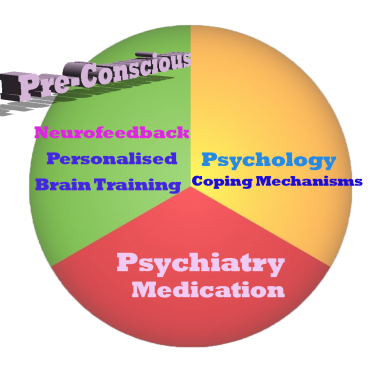
ADD / ADHD - Managing Sensory Overload
Neurofedback helps restore the ability to concentrate on the task at hand. Switching attention, changing gears and focusing on what's important is a function of good brain self-regulation. Mental calm and emotional stability are key to optimum productivity and a fulfilled social life.

Mindfulness & Meditation
Calm mental focus, well-regulated energy and emotions, the ability to shift concentration and physiological arousal level efficiently and effortlessly - these are all goals neurofeedback training and mindfulness meditation have in common. Neurofeedback prepares the brain for insightful sessions of self-reflection. Tried and tested by meditators around the world.

Peak Performance
Neurofeedback training promotes a calm mental focus - the foundation of faster, efficient performance, and limitless creative energy. A calm, well-regulated brain is able to get in 'the zone' quicker, in any performance-oriented scenario. We work on improving self-control of energy and emotions, regulating sleep and recovery, mental calming, enhancing sensory processing and improving fine motor skills and timing. Emotional stability is rooted in healthy brain self-regulation, as is physical calm - the basis for drive and speed, and to unlocking creative energy and potential, and to sustain this.
Neurofeedback is a form of complementary therapy and should not be seen as a replacement for conventional medicine. qEEG brain map-based neurofeedback training takes a more holistic approach to brain functioning, rather than just focusing on medical symptoms. It is not intended as a form of diagnosis nor medical intervention nor medical advice per the disclaimer.
Brain Maps and Personalised Brain Training Explained
Personalised Brain Training with Neurofeedback
Neurofeedback lets us train dysrythmic brain areas. With sensors comfortably fitted to the brain areas we want to train, we detect brainwave patterns real-time while watching a movie. When these patterns are inefficient, the volume drops momentarily. This is the feedback we are giving our brain, short and instantaneously.
The brain area we are training recognises this – while our conscious mind is focussed on the movie – and adjusts its behaviour to restore the normal volume. With repetition, throughout a session, learning occurs.
Meanwhile our conscious mind is solely focussed on the movie; the training process is passive in this sense.
The drop in volume is subtle, so we continue to understand the flow of the movie. No current or electrical stimulation is fed to the brain; sensors simply read brainwaves and the feedback is purely audio-visual.

Neurofeedback trains our Pre-Conscious Mind
Rather than engaging the conscious mind, which slows us down, we are training preconscious processes.
This equips us with the ability to live in the moment and attain our potential (if we have to resort to conscious control, we are not living in the moment).
We take a holistic approach to healthy brain self-regulation, rather than categorisation or diagnosis.
Personalised Brain Training is an advanced qEEG brain map-based approach to neurofeedback training developed by the founders of the field. Taking Othmer Method / ILF training methods further, it employs Default Network Training protocols as developed by David Kaiser.

Neurofeedback is Evidence-based
Neurofeedback training is an evidence-based complementary therapy. Its efficacy was first demonstrated some 50 years ago, and with advances in technology, training protocols have become more efficient and the feedback method – watching movies – thoroughly enjoyable.
Neurofeedback is evidence-based. It’s first application was discovered in 1971 when it was used to resolve intractable epilepsy.
There are over 2,000 peer-reviewed research reports on PubMed demonstrating efficacy across a number of pathologies.
In the US, it is an accepted complementary treatment for many challenges.